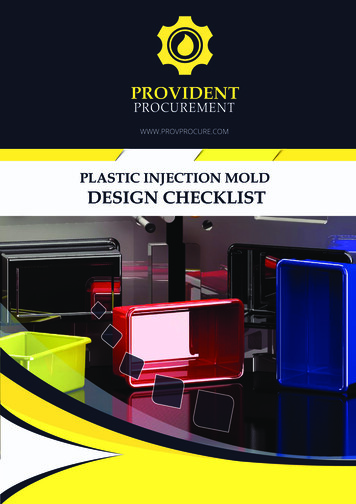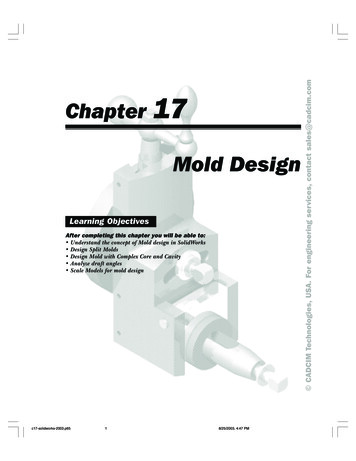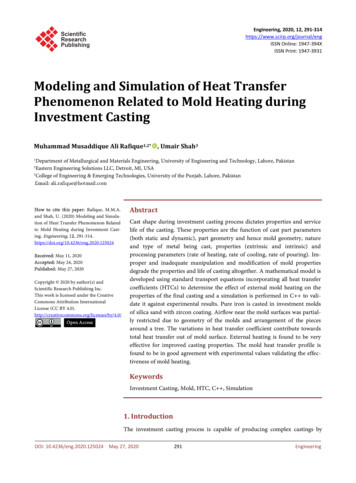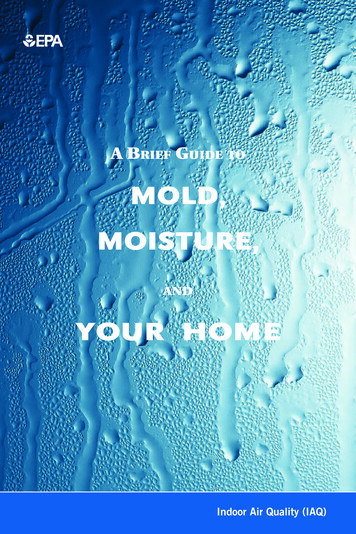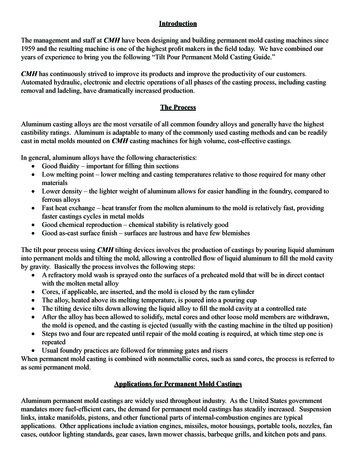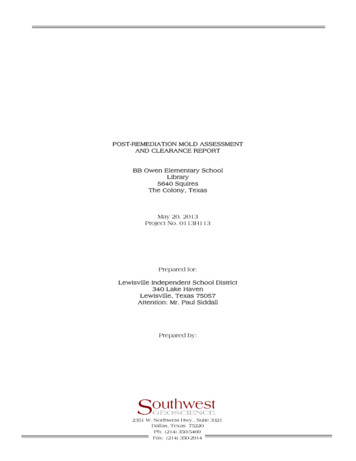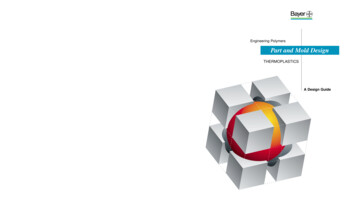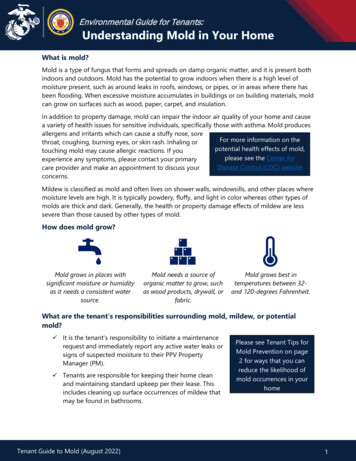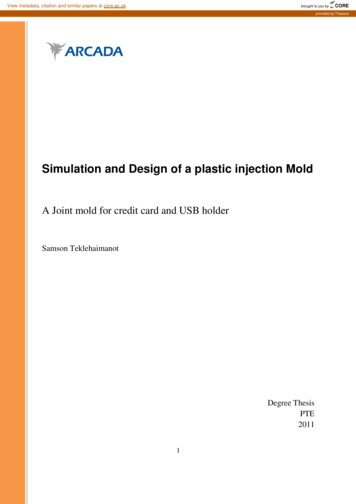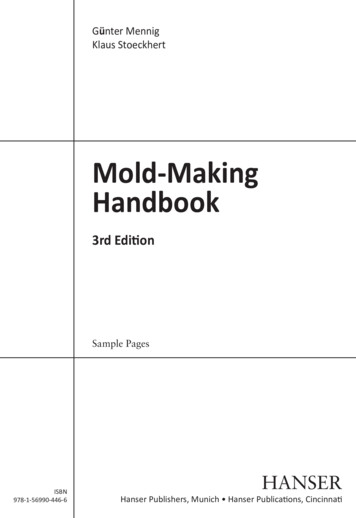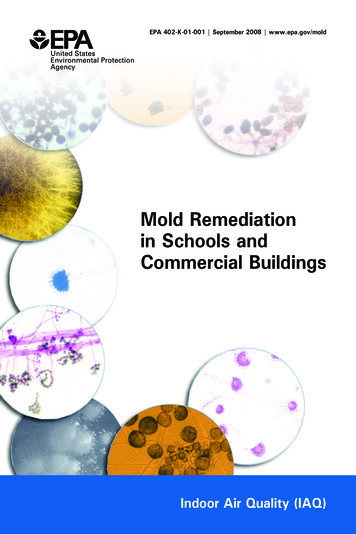
Transcription
EPA 402-K-01-001 September 2008 www.epa.gov/moldMold Remediationin Schools andCommercial BuildingsIndoor Air Quality (IAQ)
AcknowledgementsThis document was prepared by the Indoor Environments Division(IED) of the U.S. Environmental Protection Agency. IED would like tothank the reviewers of this document who provided many valuable andinsightful comments, and the contractors who provided support during thedevelopment of this document.EPA would also like to thank those who provided photos: Terry Brennan(Photo #2, Photo #3A, Photo #4A, Photo #6, Photo #8, Photo #9); PaulEllringer (Photo #4C); Stephen Vesper, Ph.D. (Photo #3B); and Chin Yang,Ph.D. (cover photos, Photo #4B, Photo #5, Photo #7).Please note that this document presents recommendations on moldremediation. EPA does not regulate mold or mold spores in indoor air.Cover Photos: Magnified photos of different species of mold
Mold Remediationin Schools andCommercial Buildings
ContentsIntroduction.1Prevention.3Investigating, Evaluating, and Remediating Moisture and MoldProblems.4Mold Remediation – Key Steps.5Plan the Remediation Before Starting Work.6Remediation Plan.6HVAC System.7Hidden Mold.8Remediation.9Table 1: Water Damage – Cleanup and Mold Prevention.10Table 2: Mold Remediation Guidelines.12Cleanup Methods.16Personal Protective Equipment (PPE).19Containment.21Equipment.23How Do You Know When You Have FinishedRemediation/Cleanup?.26Checklist for Mold Remediation.27Resources List.29References.35Appendix A – Glossary.37Appendix B – introduction to molds.39Molds in the Environment.39Health Effects and Symptoms Associated with Mold Exposure.39Mold Toxins.41Microbial Volatile Organic Compounds (mVOCs).43Glucans or Fungal Cell Wall Components.43Spores.43Appendix C – Communication With Building Occupants.45Mold in Schools.45index.47
IntroductionConcern about indoor exposure to mold has been increasing as the publicbecomes aware that exposure to mold can cause a variety of health effectsand symptoms, including allergic reactions. This document presentsguidelines for the remediation/cleanup of mold and moisture problemsin schools and commercial buildings; these guidelines include measuresdesigned to protect the health of building occupants and remediators. Ithas been designed primarily for building managers, custodians, and otherswho are responsiblefor commercialbuilding and schoolMolds gradually destroy the things they grow on. Preventmaintenance. It shoulddamage to building materials and furnishings, save money,serve as a referenceand avoid potential health risks by controlling moisture andfor potential mold andeliminating mold growth.moisture remediators.Using this document,individuals with littleor no experience withmold remediationshould be able tomake a reasonablejudgment as to whetherthe situation can behandled in-house.It will help those incharge of maintenanceto evaluate an inhouse remediationplan or a remediationplan submitted by anoutside contractor.1Contractors and otherPhoto 2: Extensive mold contamination of ceiling and wallsprofessionals whorespond to mold andmoisture situationsin commercial buildings and schools may also want to refer to theseguidelines.1If you choose to use outside contractors or professionals, make sure they have experience cleaning upmold, check their references, and have them follow the recommendations presented in this document, theguidelines of the American Conference of Government Industrial Hygienists (ACGIH) (see Resources List),and/or guidelines from other professional organizations.Mold Remediation in Schools and Commercial Buildings1
Molds can be found almost anywhere; they can grow on virtually anyorganic substance, as long as moisture and oxygen are present. There aremolds that can grow on wood, paper, carpet, foods, and insulation. Whenexcessive moisture accumulates in buildings or on building materials,mold growth will often occur, particularly if the moisture problem remainsundiscovered or unaddressed. It is impossible to eliminate all mold andmold spores in the indoor environment. However, mold growth can becontrolled indoors by controlling moisture indoors.Molds reproduce by making spores that usually cannot be seen withoutmagnification. Mold spores waft through the indoor and outdoor aircontinually. When mold spores land on a damp spot indoors, they maybegin growing and digesting whatever they are growing on in order tosurvive. Molds gradually destroy the things they grow on.Many types of molds exist. All molds have the potential to cause healtheffects. Molds can produce allergens that can trigger allergic reactions oreven asthma attacks in people allergic to mold. Others are known to producepotent toxins and/or irritants. Potential health concerns are an importantreason to prevent mold growth and to remediate/clean up any existingindoor mold growth.Since mold requires water to grow, it is important to prevent moistureproblems in buildings. Moisture problems can have many causes, includinguncontrolled humidity. Some moisture problems in buildings have beenlinked to changes in building construction practices during the 1970s, ’80s,and ’90s. Some of these changes have resulted in buildings that are tightlysealed, but may lack adequate ventilation, potentially leading to moisturebuildup. Building materials, such as drywall, may not allow moisture toescape easily. Moisture problems may include roof leaks, landscapingor gutters that direct water into or under the building, and unventedcombustion appliances. Delayed maintenance or insufficient maintenanceare also associated with moisture problems in schools and large buildings.Moisture problems in portable classrooms and other temporary structureshave frequently been associated with mold problems.2Mold Remediation in Schools and Commercial Buildings
When mold growth occurs in buildings, adverse health problems may bereported by some building occupants, particularly those with allergies orrespiratory problems. Remediators should avoid exposing themselves andothers to mold-laden dusts as they conduct their cleanup activities. Cautionshould be used to prevent mold and mold spores from being dispersedthroughout the air where they can be inhaled by building occupants.PreventionThe key to mold control is moisture control. Solve moisture problemsbefore they become mold problems!Mold Prevention Tips Fix leaky plumbing and leaks in the building envelope as soon aspossible. Watch for condensation and wet spots. Fix source(s) of moistureproblem(s) as soon as possible. Prevent moisture due to condensation by increasing surface temperatureor reducing the moisture level in air (humidity). To increase surfacetemperature, insulate or increase air circulation. To reduce the moisturelevel in air, repair leaks, increase ventilation (if outside air is cold anddry), or dehumidify (if outdoor air is warm and humid). Keep heating, ventilation, and air conditioning (HVAC) drip pans clean,flowing properly, and unobstructed. Vent moisture-generating appliances, such as dryers, to the outsidewhere possible. Maintain low indoor humidity, below 60% relative humidity (RH), ideally30 – 50%, if possible. Perform regular building/HVAC inspections and maintenance asscheduled. Clean and dry wet or damp spots within 48 hours. Don’t let foundations stay wet. Provide drainage and slope the groundaway from the foundation.Mold Remediation in Schools and Commercial Buildings3
Investigating, Evaluating, and RemediatingMoisture and Mold ProblemsSafety Tips While Investigating and EvaluatingMold and Moisture Problems Do not touch mold or moldy items with bare hands. Do not get mold or mold spores in your eyes. Do not breathe in mold or mold spores. Consult Table 2 and text for Personal Protective Equipment(PPE) and containment guidelines. Consider using PPE when disturbing mold. The minimum PPEis an N-95 respirator, gloves, and eye protection.Moldy Areas Encountered During an InvestigationPhoto 3A: Mold growing in closet as aresult of condensation from room air4Photo 3B: Front side of wallboardlooks fine, but the back side iscovered with moldMold Remediation in Schools and Commercial Buildings
Mold Remediation in Schools and Commercial Buildings5Discard moldyitems that can’tbe cleanedClean and drymoldy materialsSee Table 2Check for return ofmoisture and mold problemRemediateHidden mold discovered,reevaluate planSelect containmentequipmentOutside expertiseFix water ormoisture problemIn-house expertiseSelect remediationpersonnel or teamIdentify source orPlan remediation,adapt guidelines tofit situation, see Tables 1 & 2cause of water ormoisture problemCommunicate with buildingoccupants throughout processas appropriate to situationAssess size of mold problemand note type ofmold-damaged materialsDry non-moldy itemswithin 48 hoursSee Table 1Selectremediation managerSelect personal protectiveequipment (PPE)Consult health professionalas appropriatethroughout processMold Remediation – Key Steps
Plan the Remediation Before Starting WorkRemediation PlanQuestions to Consider BeforeRemediating Are there existing moistureproblems in the building? Have building materials beenwet more than 48 hours? (SeeTable 2 and text) Are there hidden sources ofwater or is the humidity toohigh (high enough to causecondensation)? Are building occupants reportingmusty or moldy odors? Are building occupants reportinghealth problems? Are building materials orfurnishings visibly damaged? Has maintenance been delayedor the maintenance plan beenaltered? Has the building been recentlyremodeled or has building usechanged?Assess the size of the mold and/or moistureproblem and the type of damaged materialsbefore planning the remediation work.Select a remediation manager for mediumor large jobs (or small jobs requiring morethan one person). The remediation planshould include steps to fix the water ormoisture problem, or the problem mayreoccur. The plan should cover the use ofappropriate Personal Protective Equipment(PPE) and include steps to carefullycontain and remove moldy buildingmaterials to avoid spreading the mold.2A remediation plan may vary greatlydepending on the size and complexityof the job, and may require revision ifcircumstances change or new facts arediscovered.The remediation manager’s highest prioritymust be to protect the health and safety ofthe building occupants and remediators.It is also important to communicatewith building occupants when moldproblems are identified.3 In some cases, Is consultation with medical orhealth professionals indicated?2Molds are known allergens and may be toxic. You may wish to use Personal Protective Equipment (PPE)while investigating a mold problem, as well as during remediation/cleanup situations. The minimum PPEincludes an N-95 respirator, gloves, and eye protection.36See Appendix C.Mold Remediation in Schools and Commercial Buildings
especially those involving large areas of contamination, the remediationplan may include temporary relocation of some or all of the buildingoccupants. The decision to relocate occupants should consider the sizeand type of the area affected by mold growth, the type and extent of healtheffects reported by the occupants, the potential health risks that could beassociated with debris, and the amount of disruption likely to be causedby remediation activities. If possible, remediation activities should bescheduled for off-hours when building occupants are less likely to beaffected.Remediators, particularly those with health-related concerns, may wish tocheck with their doctors or health care professionals before working onmold remediation or investigating potentially moldy areas. If you haveany doubts or questions, you should consult a health professional beforebeginning a remediation project.HVAC SystemDo not run the HVAC system if you know or suspect that it is contaminatedwith mold. If you suspect that it may be contaminated (it is part of anidentified moisture problem, for instance, or there is mold growth near theintake to the system), consult EPA’s guide Should You Have the Air Ductsin Your Home Cleaned?4 before taking further action (see Resources List).Photo 4B:Mold growthon air diffuserin ceilingPhoto 4C:Moldy air ductPhoto 4A: Contaminated fibrousinsulation inside air handlercover4Although this document has a residential focus, it is applicable to other building types.Mold Remediation in Schools and Commercial Buildings7
Hidden MoldIn some cases, indoor mold growth may not be obvious. It is possiblethat mold may be growing on hidden surfaces, such as the back side ofdrywall, wallpaper, or paneling, the top of ceiling tiles, the underside ofcarpets and pads, etc. Possible locations of hidden mold can include pipechases and utility tunnels (with leaking or condensing pipes), walls behindfurniture (where condensation forms),condensate drain pans inside airHidden Mold Growthhandling units, porous thermal oracoustic liners inside ductwork, or roofmaterials above ceiling tiles (due toroof leaks or insufficient insulation).Some building materials, such asdrywall with vinyl wallpaper over itor wood paneling, may act as vaporbarriers,5 trapping moisture underneaththeir surfaces and thereby providinga moist environment where mold cangrow. You may suspect hidden moldif a building smells moldy, but youcannot see the source, or if you knowPhoto 5: Mold growth behind wallpaperthere has been water damage andbuilding occupants are reporting healthproblems. Investigating hidden moldproblems may be difficult and will require caution when the investigationinvolves disturbing potential sites of mold growth—make sure to use PPE.For example, removal of wallpaper can lead to a massive release of sporesfrom mold growing on the underside of the paper. If you believe that youmay have a hidden mold problem, you may want to consider hiring anexperienced professional. If you discover hidden mold, you should reviseyour remediation plan to account for the total area affected by mold growth.5For more information on vapor barriers and building construction, see Resources List. It is important thatbuilding materials be able to dry; moisture should not be trapped between two vapor barriers or mold mayresult.8Mold Remediation in Schools and Commercial Buildings
Remediation1. Fix the water or humidity problem. Complete and carry out repair planif appropriate. Revise and/or carry out maintenance plan if necessary.Revise remediation plan,as necessary, if moredamage is discoveredThe Key to Mold Control is Moistureduring remediation. SeeControl!Mold Remediation –Key Steps (page 5) and When addressing mold problems, don’tResources List (page 29)forget to address the source of the moisturefor additional information.problem, or the mold problem may simply2. Continue to communicatewith building occupants, asappropriate to the situation.Be sure to address allconcerns.reappear! Remember to check for high humidity andcondensation problems as well as actualwater leaks, maintenance issues, and HVACsystem problems.3. Completely clean up mold Protect the health and safety of the buildingand dry water-damagedoccupants and remediators. Consult aareas. Select appropriatehealth professional as needed. Use PPE andcleaning and dryingcontainment as appropriate when workingmethods for damaged/with mold.contaminated materials.Carefully contain andremove moldy buildingmaterials. Use appropriate Personal Protective Equipment (PPE).Arrange for outside professional support if necessary.Mold Remediation in Schools and Commercial Buildings9
Table 1: Water Damage Cleanup and Mold Prevention6Table 1 presents strategies to respond to water damage within 24 – 48hours. These guidelines are designed to help avoid the need for remediationof mold growth by taking quick action before growth starts. If mold growthis found on the materials listed in Table 1, refer to Table 2 for guidanceon remediation. Depending on the size of the area involved and resourcesavailable, professional assistance may be needed to dry an area quickly andthoroughly.6Please note that Tables 1 and 2 contain general guidelines. Their purpose is to provide basic information forremediation managers to first assess the extent of the damage and then to determine whether the remediationshould be managed by in-house personnel or outside professionals. The remediation manager can then usethe guidelines to help design a remediation plan or to assess a plan submitted by outside professionals.10Mold Remediation in Schools and Commercial Buildings
Table 1: Water Damage – Cleanup and Mold PreventionGuidelines for Response to Clean Water Damage within 24 – 48 Hours to Prevent Mold Growth*Water-Damaged Material†ActionsBooks and papers* For non-valuable items, discard books and papers.* Photocopy valuable/important items, discard originals.* Freeze (in frost-free freezer or meat locker) or freeze-dry.Carpet and backing – drywithin 24 – 48 hours§* Remove water with water extraction vacuum.* Reduce ambient humidity levels with dehumidifier.* Accelerate drying process with fans.Ceiling tiles* Discard and replace.Cellulose insulation* Discard and replace.Concrete or cinder blocksurfaces* Remove water with water extraction vacuum.* Accelerate drying process with dehumidifiers, fans, and/or heaters.Fiberglass insulation* Discard and replace.Hard surface, porousflooring§ (Linoleum,ceramic tile, vinyl)* Vacuum or damp wipe with water and mild detergent and allow to dry; scrub ifnecessary.* Check to make sure underflooring is dry; dry underflooring if necessary.Non-porous, hard surfaces * Vacuum or damp wipe with water and mild detergent and allow to dry; scrub ifnecessary.(Plastics, metals)Upholstered furniture* Remove water with water extraction vacuum.* Accelerate drying process with dehumidifiers, fans, and/or heaters.* May be difficult to completely dry within 48 hours. If the piece is valuable, youmay wish to consult a restoration/water damage professional who specializes infurniture.Wallboard (Drywall andgypsum board)* May be dried in place if there is no obvious swelling and the seams are intact. Ifnot, remove, discard, and replace.* Ventilate the wall cavity, if possible.Window drapes* Follow laundering or cleaning instructions recommended by the manufacturer.Wood surfaces* Remove moisture immediately and use dehumidifiers, gentle heat, and fans fordrying. (Use caution when applying heat to hardwood floors.)* Treated or finished wood surfaces may be cleaned with mild detergent and cleanwater and allowed to dry.* Wet paneling should be pried away from wall for drying.*If mold growth has occurred or materials have been wet for more than 48 hours, consult Table 2 guidelines. Even ifmaterials are dried within 48 hours, mold growth may have occurred. Items may be tested by professionals if there isdoubt. Note that mold growth will not always occur after 48 hours; this is only a guideline.These guidelines are for damage caused by clean water. If you know or suspect that the water source is contaminatedwith sewage, or chemical or biological pollutants, then Personal Protective Equipment and containment are requiredby the Occupational Safety and Health Administration (OSHA). An experienced professional should be consulted if youand/or your remediators do not have expertise remediating in contaminated water situations. Do not use fans beforedetermining that the water is clean or sanitary.If a particular item(s) has high monetary or sentimental value, you may wish to consult a restoration/water damagespecialist.†The subfloor under the carpet or other flooring material must also be cleaned and dried. See the appropriate sectionof this table for recommended actions depending on the composition of the subfloor.§Mold Remediation in Schools and Commercial Buildings11
Table 2: Mold Remediation Guidelines7Table 2 presents remediation guidelines for building materials that have orare likely to have mold growth. The guidelines in Table 2 are designed toprotect the health of occupants and cleanup personnel during remediation.These guidelines are based on thearea and type of material affectedMold and Indoor Air Regulations andby water damage and/or moldStandardsgrowth. Please note that these areguidelines; some professionals mayStandards or Threshold Limit Values (TLVs)for airborne concentrations of mold, or moldprefer other cleaning methods. Ifspores, have not been set. As of Decemberyou are considering cleaning your2000, there are no EPA regulations orducts as part of your remediationstandards for airborne mold contaminants.plan, you should consult EPA’spublication entitled, Should YouHave the Air Ducts In Your HomeCleaned?8 (see Resources List). If possible, remediation activities shouldbe scheduled for off-hours when building occupants are less likely to beaffected.Although the level of personal protection suggested in these guidelines isbased on the total surface area contaminated and the potential for remediatorand/or occupant exposure, professional judgment should always play a partin remediation decisions. These remediation guidelines are based on the sizeof the affected area to make it easier for remediators to select appropriatetechniques, not on the basis of health effects or research showing thereis a specific method appropriate at a certain number of square feet. Theguidelines have been designed to help construct a remediation plan. Theremediation manager will then use professional judgment and experienceto adapt the guidelines to particular situations. When in doubt, caution isadvised. Consult an experienced mold remediator for more information.7Please note that Tables 1 and 2 contain general guidelines. Their purpose is to provide basic information forremediation managers to first assess the extent of the damage and then to determine whether the remediationshould be managed by in-house personnel or outside professionals. The remediation manager can then usethe guidelines to help design a remediation plan or to assess a plan submitted by outside professionals.812Although this document has a residential focus, it is applicable to other building types.Mold Remediation in Schools and Commercial Buildings
In cases in which a particularly toxic mold species has been identified or issuspected, when extensive hidden mold is expected (such as behind vinylwallpaper or in the HVACsystem), when the chances ofHealth Concernsthe mold becoming airborneare estimated to be high, orIf building occupants are reporting serious healthsensitive individuals (e.g.,concerns, you should consult a health professional.those with severe allergies orasthma) are present, a morecautious or conservative approach to remediation is indicated. Always makesure to protect remediators and building occupants from exposure to mold.Mold Remediation in Schools and Commercial Buildings13
Table 2: Guidelines for Remediating Building Materials with Mold GrowthCaused by Clean Water*Material or FurnishingAffectedCleanupMethods†Personal ProtectiveEquipmentContainmentSMALL – Total Surface Area Affected Less Than 10 square feet (ft2)Books and papers3Carpet and backing1, 3Concrete or cinder block1, 3Hard surface, porous flooring(Linoleum, ceramic tile, vinyl)1, 2, 3Non-porous, hard surfaces(Plastics, metals)1, 2, 3Upholstered furniture & drapes1, 3Wallboard (Drywall and gypsumboard)3Wood surfacesNone requiredMinimumN-95 respirator, gloves, andgoggles1, 2, 3MEDIUM – Total Surface Area Affected Between 10 and 100 (ft2)Books and papersCarpet and backingConcrete or cinder block31, 3, 41, 3Hard surface, porous flooring(Linoleum, ceramic tile, vinyl)1, 2, 3Non-porous, hard surfaces(Plastics, metals)1, 2, 3Upholstered furniture & drapes1, 3, 4Wallboard (Drywall and gypsumboard)3, 4Wood surfacesLimited or FullLimitedUse professional judgment,consider potential forremediator exposure and sizeof contaminated areaUse professional judgment,consider potential forremediator/occupant exposureand size of contaminatedarea1, 2, 3LARGE – Total Surface Area Affected Greater Than 100 (ft2) or Potential forIncreased Occupant or Remediator Exposure During Remediation Estimated to be SignificantBooks and papersCarpet and backingConcrete or cinder blockHard surface, porous flooring(Linoleum, ceramic tile, vinyl)31, 3, 41, 31, 2, 3, 4Non-porous, hard surfaces(Plastics, metals)1, 2, 3Upholstered furniture & drapes1, 3, 4Wallboard (Drywall and gypsumboard)3, 4Wood surfaces141, 2, 3, 4FullFullUse professional judgment,consider potential forremediator exposure and sizeof contaminated areaUse professional judgment,consider potential forremediator/occupant exposureand size of contaminatedarea
Table 2 continued*Use professional judgment to determine prudent levels of Personal Protective Equipment and containmentfor each situation, particularly as the remediation site size increases and the potential for exposureand health effects rises. Assess the need for increased Personal Protective Equipment, if, during theremediation, more extensive contamination is encountered than was expected. Consult Table 1 if materialshave been wet for less than 48 hours, and mold growth is not apparent.These guidelines are for damage caused by clean water. If you know or suspect that the water source iscontaminated with sewage, or chemical or biological pollutants, then the Occupational Safety and HealthAdministration (OSHA) requires PPE and containment. An experienced professional should be consulted ifyou and/or your remediators do not have expertise in remediating contaminated water situations.Select method most appropriate to situation. Since molds gradually destroy the things they grow on, if moldgrowth is not addressed promptly, some items may be damaged such that cleaning will not restore theiroriginal appearance. If mold growth is heavy and items are valuable or important, you may wish to consult arestoration/water damage/remediation expert. Please note that these are guidelines; other cleaning methodsmay be preferred by some professionals.†Cleanup MethodsMethod 1: Wet vacuum (in the case of porous materials, some mold spores/fragments will remain in thematerial but will not grow if the material is completely dried). Steam cleaning may be an alternative forcarpets and some upholstered furniture.Method 2: Damp-wipe surfaces with plain water or with water and detergent solution (except wood—usewood floor cleaner); scrub as needed.Method 3: High-efficiency particulate air (HEPA) vacuum after the material has been thoroughly dried.Dispose of the contents of the HEPA vacuum in well-sealed plastic bags.Method 4: Discard – remove water-damaged materials and seal in plastic bags while inside of containment,if present. Dispose of as normal waste. HEPA vacuum area after it is dried.Personal Protective Equipment (PPE)Minimum: Gloves, N-95 respirator, goggles/eye protectionLimited: Gloves, N-95 respirator or half-face respirator with HEPA filter, disposable overalls, goggles/eyeprotectionFull: Gloves, disposable full body clothing, head gear, foot coverings, full-face respirator with HEPA filterContainmentLimited: Use polyethylene sheeting ceiling to floor around affected area with a slit entry and covering flap;maintain area under negative pressure with HEPA-filtered fan unit. Block supply and return air vents withincontainment area.Full: Use two layers of fire-retardant polyethylene sheeting with one airlock chamber. Maintain area undernegative pressure with HEPA-filtered fan exhausted outside of building. Block supply and return air ventswithin containment area.Table developed from literature and remediation documents including Bioaerosols: Assessment andControl (American Conference of Governmental Industrial Hygienists, 1999) and IICRC S500, Standardand Reference Guide for Professional Water Damage Restoration (Institute of Inspection, Cleaning andRestoration, 1999); see Resources List for more information.15
Cleanup MethodsA variety
2 Mold Remediation in Schools and Commercial Buildings Molds can be found almost anywhere; they can grow on virtually any organic substance, as long as moisture and oxygen are present. . Mold Remediation in Schools and Commercial Buildings 3 When mold growth occurs in buildings, adverse health problems may be
